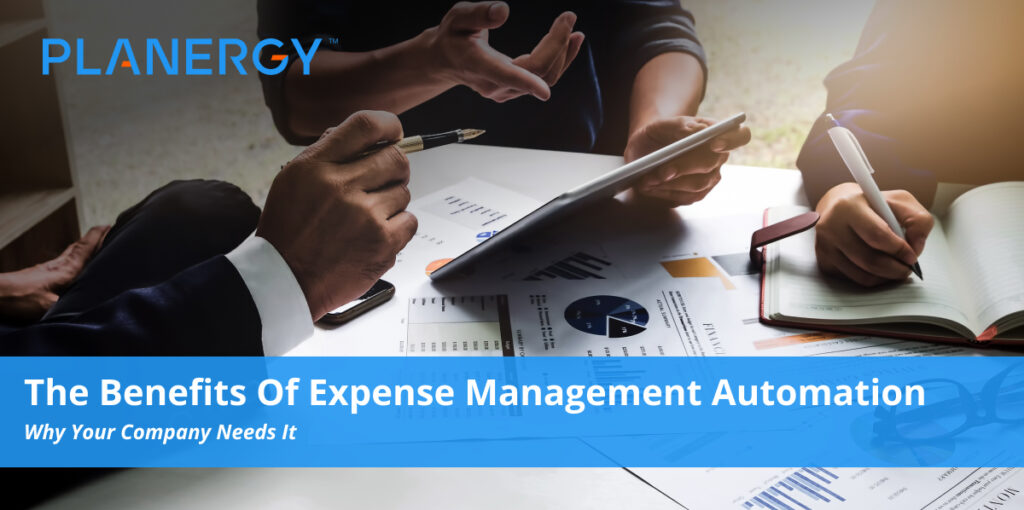Many businesses rely on invoice processing automation to help improve productivity and decrease the frequency of financial error.
With expense management automation, businesses can further their productivity and keep a closer eye on the company’s second-largest controllable cost – employee business expenses.
Even if you have tightly controlled limits on corporate credit card accounts, keeping track of everything can be a big hassle.
Research shows that processing a single expense report costs an average of $58. If your organization has 10 employees away on business trips to will it submit expense reports, statistically, you’re spending nearly $600 to process the reports.
Your business will be far better served by using that $580 to invest in an expense management system to automate your expense management processes much the same way your procurement processes can be automated.
Automation Eliminates Paperwork and Manual Reporting
There’s no need to keep a paper record of everything or spend hours creating and editing spreadsheets with formulas. Your employees have to keep track of their paper receipts to record expenses, and the finance team has to go through all the paperwork to verify everything and approve the expense reports.
That takes time and leaves plenty of room for error. Even if your staff submits perfect expense reports, the finance team can still make mistakes when transferring information from the spreadsheet to the accounting system.
Automation eliminates paperwork because when an expense management system is in place, employees can capture their receipts with their smartphones, then upload them to the expense platform via a mobile app.
From there, they can quickly compile it all into an expense report and submit directly to the finance department.
Even if an error is made, the finance department can trace it back to where it occurred, which is difficult to do with paper records.
Makes Approval and Reimbursement Faster
Turning to an automated expense management solution speeds up both approval and reimbursement.
With the manual process, finance managers and accountants spend a lot of time reviewing each expense report and moving tasks from one approver to another, which causes delayed reimbursement.
If a group of employees has just returned from a business trip, your finance team will end up with a stack of envelopes full of receipts on their desks by the end of the day.
Then, they’ll have to check to make sure each receipt is legitimate by verifying it against the policy. If they put one of the envelopes off for a few days, or unintentionally miss a receipt, the employee’s reimbursement is inaccurate.
With an automated system to handle the approval process, once an approver has approved the report, the task automatically goes to the next approver in line, who is notified to complete their part of the process. Once the approvals are collected, the finance manager can review and reimburse the expense with ease.
Protects Against Expense Fraud
When you rely on manual processes, you’re making it easier for employees to commit expense theft. It’s possible to submit the same receipt twice, and round up mileage expenses.
Controlling things like this because manual processing makes it hard to identify suspicious claims and follow up with the employee to resolve the issue.
An easy way to rid your company of expense fraud is to automate travel expense management.
Automate will pick up on duplicate entries where the same expense is submitted more than once and sends the submitter (and approver) a message to have them either merge or delete the expense.
Using customized workflows, you not only streamline efforts but increase overall transparency because you can set up a double review process, so there’s at least one other review after the approver reviews it before reimbursing the expense, ensuring that all expense reimbursements are valid and accurate.
Increased Spend Visibility
Manual expense management is not only time-consuming, but it also makes it hard to have real-time visibility into your expenses.
Even though you can use the reports and spreadsheets, that data is often outdated by the time you analyze it. Accounting software may automatically generate reports, but without that current expense data, anything you derive from it won’t give a completely accurate picture of what the company’s financial situation looks like.
Even if your accounting teams go through everything on a weekly basis and come up with a report, this isn’t enough to make quick and informed decisions.
Most expense management systems provide an extensive library of report options from expenses, trips, to policy violations, reimbursements, and more. You can use the policy violators report to determine the employees who are most often submitting business travel expenses outside of your policy.
You can generate an “Expenses by category” report to see patterns in staff spending. Beyond making decisions quickly, these reports make it easier for your finance and travel teams to work together to narrow down the best vendors for airline travel and hotel stays.
This way, your procurement team can work to negotiate a better deal for cost savings.
Improves Policy Compliance Rates
Without formal expense management software in place, it can be difficult to enforce expense policies, which makes maintaining compliance nearly impossible.
Once a variety of expenses start coming in, it’s hard for the finance team to make sure the expenditures are properly entered into the spreadsheet. They would have to manually validate each expense against the travel expense policy.
Not only this but manually processing expenses also allows for out-of-policy transactions to slip through, meaning you’re paying employees for doing something they’re not supposed to.
You can customize the entire process so everything is in line with your company’s travel policy. The system will automatically notify approvers of employee expenses that violate the travel policy, as they occur. This allows your team to check for compliance and approve or reject expense claims in real-time, with just a few clicks.
It’s also a good way to educate your team on what they can and cannot spend, and the approved vendors they can spend with.
If an employee tries to submit an expense that’s outside of the hotel rate, meal allowance, or is otherwise is not allowed by the policy, they’ll be notified and the policy is communicated immediately and consistently. Over time, the employees learn the policy and ultimately change their behavior.
Using expense management automation, the average company can reduce processing time and costs by 40 to 60%, with the investment paying for itself in six to 12 months. In a typical company, the platform can:
- Reduce expense report competition time from 35 to 18 minutes.
- Reduce accounts payable processing time from 22 to five minutes.
- Reduce processing costs from $58 to $18 per transaction.
- Reduce expense submissions turnaround time from 14 days to three days.
- Reduce the time it takes to generate an expense report by 75%.
With software as a service (SaaS) management tool, everything is accessible from an internet connection and remains up-to-date in real-time.
While the obvious benefit is the resource savings in the expense processing tasks, there’s also the benefit of cost savings within the audit and analysis process.
With a clearer vision into what your employees and spending and where, you’ll be better equipped to analyze and manage the spend, finding cost savings where you may have otherwise left money on the table.
Expense management automation is a strategic solution that gives your company a competitive edge compared to companies that don’t use it.
You’ll control overall spending, ensure policy compliance, reduce processing costs, and increase employee productivity.




